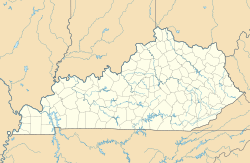Thompson site facts for kids
| Location | South Portsmouth, Kentucky, Greenup County, Kentucky, |
|---|---|
| Region | Greenup County, Kentucky |
| Coordinates | 38°43′25.39″N 83°1′8.72″W / 38.7237194°N 83.0190889°W |
| History | |
| Founded | 1100 CE |
| Abandoned | 1200 CE |
| Periods | Croghan Phase |
| Cultures | Fort Ancient culture |
The Thompson site is an important archaeological site located near South Portsmouth, Kentucky in Greenup County, Kentucky. It sits right next to the Ohio River, directly across from where the Scioto River flows into it. This site was once a village for people of the Fort Ancient culture, a group of Native Americans who lived in this area many centuries ago.
Contents
Discovering the Thompson Site
The Thompson site is a special place because it helps us learn about the past. Archaeologists, who are like history detectives, study places like this to understand how people lived long ago. They look for clues left behind, such as tools, pottery, and the remains of homes.
Who Were the Fort Ancient People?
The Fort Ancient culture was a group of Native American people who lived in the Ohio River Valley from about 1000 CE to 1750 CE. They were skilled farmers, growing crops like corn, beans, and squash. They also hunted animals and gathered wild plants for food. These communities often lived in villages, sometimes surrounded by walls for protection.
Life in a Fort Ancient Village
Life in a Fort Ancient village was busy. People worked together to grow food, make pottery, and craft tools from stone and bone. They built homes, often made of wood and thatch. Villages were usually located near rivers, which provided water, food, and a way to travel. The Ohio River was like a superhighway for these ancient communities.
When Was the Thompson Site Used?
The Thompson site was active during a specific time period called the Croghan Phase. This phase lasted from about 1100 CE to 1200 CE. This means people lived at the Thompson site for about 100 years.
The Croghan Phase Explained
The Croghan Phase is a name archaeologists use to describe a particular time and style of culture in the local area. During this time, the Fort Ancient people at Thompson site would have been developing their farming techniques and community structures.
Comparing Ancient Villages
The Thompson site, during its Croghan Phase, was around at the same time as other Fort Ancient villages in the Scioto River valley. These other villages are part of what archaeologists call the Baum Phase. This means that while the people at Thompson were living their lives, similar communities were thriving nearby. They likely traded with each other and shared ideas.
Why the Thompson Site Matters
Studying the Thompson site gives us valuable information about the Fort Ancient culture. It helps us understand their daily lives, their customs, and how their communities were organized. Each artifact found at the site tells a piece of the story of these ancient people.
Learning from the Past
Archaeological sites like Thompson are like open-air museums. They allow us to connect with people who lived hundreds of years ago. By protecting and studying these sites, we ensure that future generations can also learn about the rich history of Native Americans in Kentucky and beyond.


